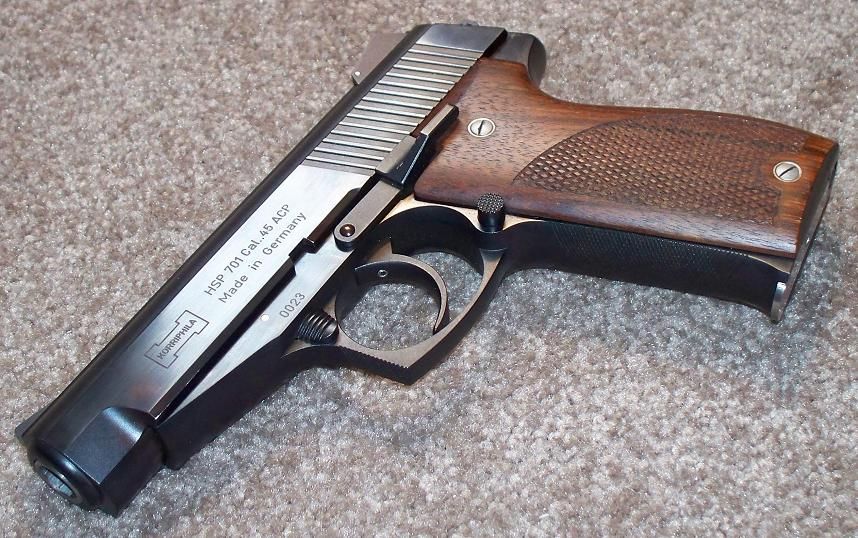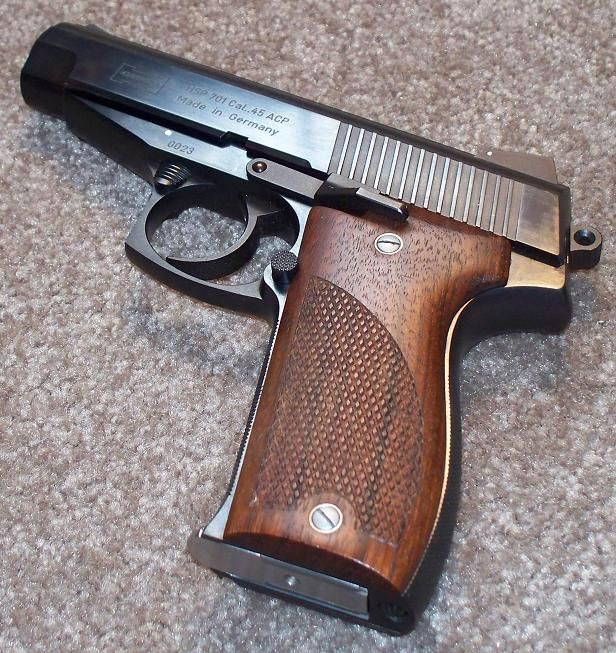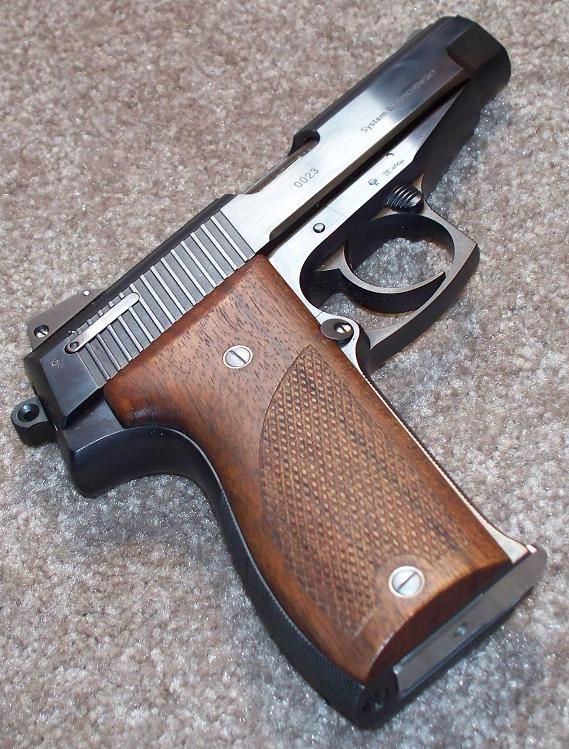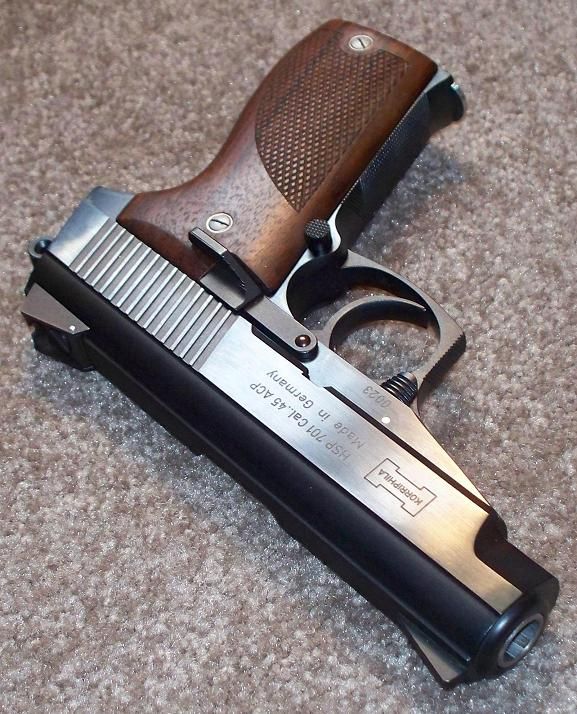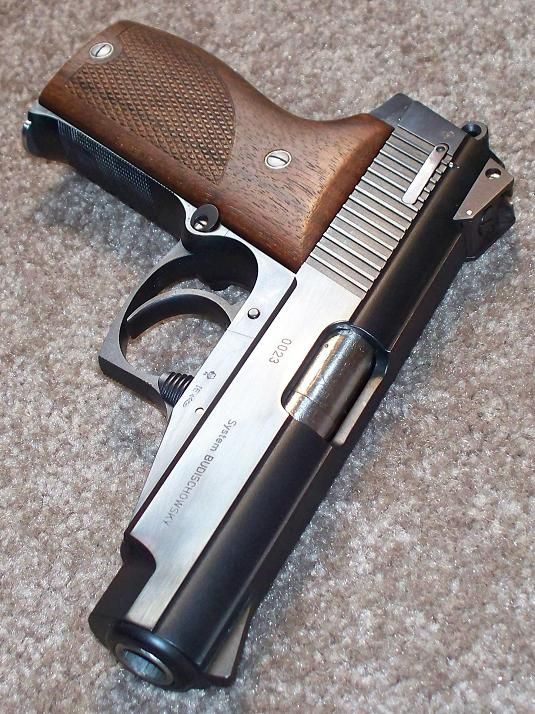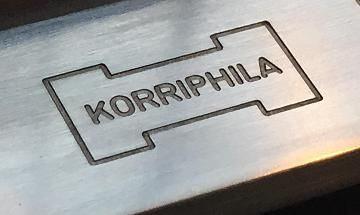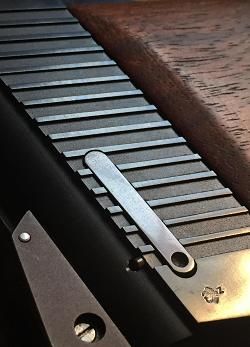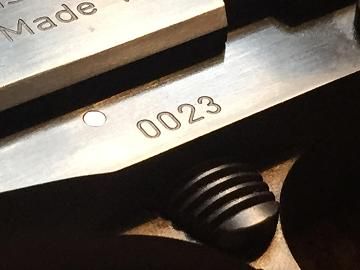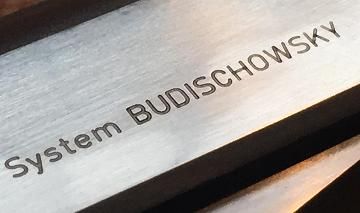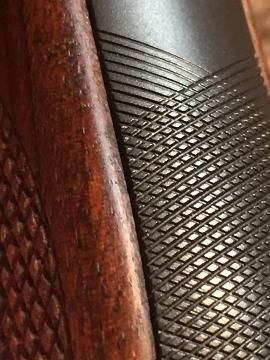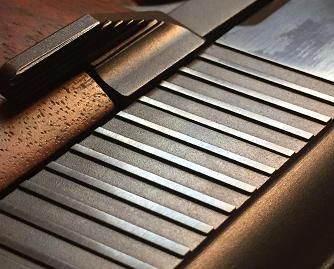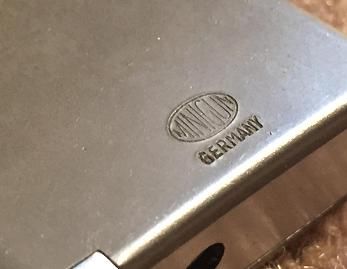The Korriphila HSP 701 was the masterwork of the Czech designer, Edgar Budischowsky. As far as I know, the patent for the design was granted in 1979 and production started in 1983. They were totally hand built on a custom, one at a time basis in Heidelberg, Germany. It was basically manufactured with no regard to cost whatsoever. Budischowsky’s goal was to build the highest quality pistol in the world with reliability and accuracy to match. This was not a pistol built for anyone’s military and certainly not a production gun. They were only built in extremely limited numbers (less than 30 per year). It was recently rumored that Budischowsky was going to gear up for one final run, but, unfortunately, that never came to fruition. 
All parts are cut from solid billet steel and are of unmatched form and quality (at least in my collection). The attention to detail and steel work is simply off the charts, of which I tried to capture in some of the photos. Besides all of that, what struck me the most was just how tight the gun is. Nothing moves. There is no slide to frame play at all. Racking the slide takes some effort. Once the slide is back, there is still no movement. You can shake the gun quickly and there is no rattle. It honestly feels like one piece of steel in my hand. I’m not sure I even own a custom 1911 that feels like this. When field stripping the gun, the two take down levers are not just spring loaded, but actually lock into the downward position with a distinct “click" and all the security of a bank vault. They are not released until the slide pushes down a rearward lever upon going back onto the frame. I was just floored by how secure and precise it felt. Internally, the gun is a marvel of craftsmanship with everything fit like a Swiss watch. Externally, what looks like checkering at first glance, are actually fine criss-crossed lines on the front strap, back strap, and trigger guard. The roll marking was clearly done by hand and is amongst the nicest I have in the collection. The bluing is semi glossy and beautiful to look at. Its that perfect middle ground between matte and high gloss blue. The small plate on the right side that resembles an extractor is actually a lever used to remove the firing pin assembly from the slide after removing the slide from the frame. There is no decocker. When chambering a round, the hammer follows the slide, eliminating the need for any additional lever on the pistol. This is obviously the work of a master gunsmith producing a gun without limitations. Its easy to see why Jeff Cooper spoke so fondly of the HSP when Budischowsky first started production. I’m totally in awe of the gun. Its a spectacular piece of almost otherworldly precision, refinement, and just total class.
Make no mistake, however. This is not just an ultra high end show piece. The design is serious. Its of a roller-delayed blowback, similar to an HK P9S. The barrel is fixed, the bore axis relatively low, and the ergonomics superb. The perfectly positioned DA trigger has a very short, smooth travel and reset. The SA trigger is light and precise with very little take up and absolutely zero creep. The slide top is flattened and finely serrated. The wood grips are tastefully hand checkered. As mentioned, initial break down is done via two levers on either side of the frame, not unlike that of a CZ 52. However, the slide does not lift off the frame in the same fashion. You need to pull it back and up and then forward over the fixed barrel. As you can imagine, this pistol is dense and heavy. Despite having a relatively short barrel and slide, it weighs in just under 40oz empty and is heavier than many of my full size, all steel 1911s.
As you can see, this is a very early pistol, dating from 1984 with serial number 0023. Condition is superb at 98-99%. Its a 31 year old firearm that looks brand new other than a couple grip screws. As many know, I love beautiful bluing coupled with walnut grips and this pistol has it in spades. The adjustable rear sight is shielded much like some old S&W autos. Another interesting feature is the small loaded chamber indicator on the rear of the slide above the hammer. One of the best things about this particular example is that there are no import markings. While most importation stamps don’t normally bother me, they probably would on something like this. The few that I’ve actually seen in online pictures in searches over the years are usually adorned with a large, ugly stamp on the right side of the slide.
I strongly feel that you would be hard pressed to find a nicer post WWII semi auto pistol anywhere in the world. If one does exist, I’ve never seen or heard it. In my eyes, this is the pinnacle of quality, design, fitting, and refinement, of which I've never seen an equal. While pictures don't begin to do the pistol justice, I think you can see how well the HSP is put together. If there was ever a pistol in which you could realize the high density, smoothness, and hardness of the steel without actually touching it, its the Korriphila. Its old world quality at its absolute best.
Being there is very little about these guns available online, I thought I'd give it 15 minutes of fame.
Please enjoy the pictures...
.
All parts are cut from solid billet steel and are of unmatched form and quality (at least in my collection). The attention to detail and steel work is simply off the charts, of which I tried to capture in some of the photos. Besides all of that, what struck me the most was just how tight the gun is. Nothing moves. There is no slide to frame play at all. Racking the slide takes some effort. Once the slide is back, there is still no movement. You can shake the gun quickly and there is no rattle. It honestly feels like one piece of steel in my hand. I’m not sure I even own a custom 1911 that feels like this. When field stripping the gun, the two take down levers are not just spring loaded, but actually lock into the downward position with a distinct “click" and all the security of a bank vault. They are not released until the slide pushes down a rearward lever upon going back onto the frame. I was just floored by how secure and precise it felt. Internally, the gun is a marvel of craftsmanship with everything fit like a Swiss watch. Externally, what looks like checkering at first glance, are actually fine criss-crossed lines on the front strap, back strap, and trigger guard. The roll marking was clearly done by hand and is amongst the nicest I have in the collection. The bluing is semi glossy and beautiful to look at. Its that perfect middle ground between matte and high gloss blue. The small plate on the right side that resembles an extractor is actually a lever used to remove the firing pin assembly from the slide after removing the slide from the frame. There is no decocker. When chambering a round, the hammer follows the slide, eliminating the need for any additional lever on the pistol. This is obviously the work of a master gunsmith producing a gun without limitations. Its easy to see why Jeff Cooper spoke so fondly of the HSP when Budischowsky first started production. I’m totally in awe of the gun. Its a spectacular piece of almost otherworldly precision, refinement, and just total class.
Make no mistake, however. This is not just an ultra high end show piece. The design is serious. Its of a roller-delayed blowback, similar to an HK P9S. The barrel is fixed, the bore axis relatively low, and the ergonomics superb. The perfectly positioned DA trigger has a very short, smooth travel and reset. The SA trigger is light and precise with very little take up and absolutely zero creep. The slide top is flattened and finely serrated. The wood grips are tastefully hand checkered. As mentioned, initial break down is done via two levers on either side of the frame, not unlike that of a CZ 52. However, the slide does not lift off the frame in the same fashion. You need to pull it back and up and then forward over the fixed barrel. As you can imagine, this pistol is dense and heavy. Despite having a relatively short barrel and slide, it weighs in just under 40oz empty and is heavier than many of my full size, all steel 1911s.
As you can see, this is a very early pistol, dating from 1984 with serial number 0023. Condition is superb at 98-99%. Its a 31 year old firearm that looks brand new other than a couple grip screws. As many know, I love beautiful bluing coupled with walnut grips and this pistol has it in spades. The adjustable rear sight is shielded much like some old S&W autos. Another interesting feature is the small loaded chamber indicator on the rear of the slide above the hammer. One of the best things about this particular example is that there are no import markings. While most importation stamps don’t normally bother me, they probably would on something like this. The few that I’ve actually seen in online pictures in searches over the years are usually adorned with a large, ugly stamp on the right side of the slide.
I strongly feel that you would be hard pressed to find a nicer post WWII semi auto pistol anywhere in the world. If one does exist, I’ve never seen or heard it. In my eyes, this is the pinnacle of quality, design, fitting, and refinement, of which I've never seen an equal. While pictures don't begin to do the pistol justice, I think you can see how well the HSP is put together. If there was ever a pistol in which you could realize the high density, smoothness, and hardness of the steel without actually touching it, its the Korriphila. Its old world quality at its absolute best.
Being there is very little about these guns available online, I thought I'd give it 15 minutes of fame.
Please enjoy the pictures...
.
Last edited:

